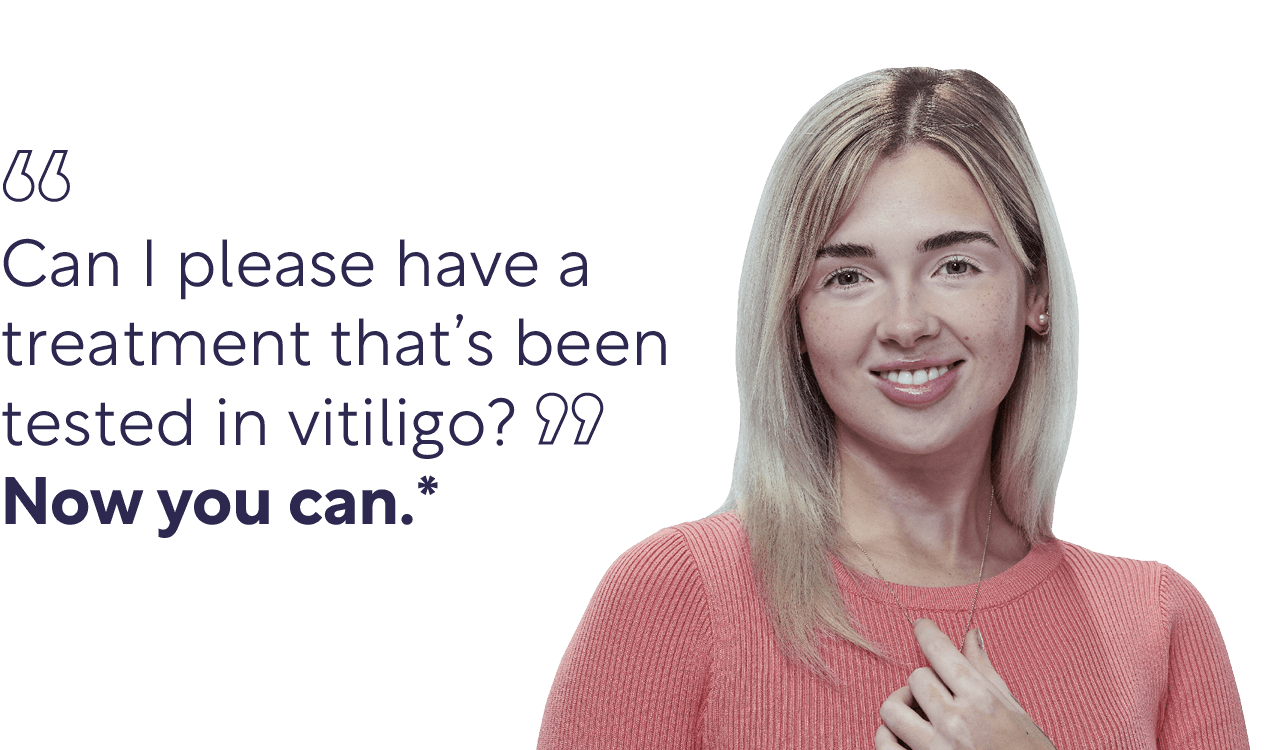
Adapted from Rosmarin et al. 2022.
Intended for licensed healthcare professionals located in the United Kingdom and Republic of Ireland only
Opzelura® is indicated for the treatment of non-segmental vitiligo
with facial involvement in adults and adolescents from 12 years of age1


In the TRuE-V1 study, the primary endpoint, F-VASI75 response at Week 24 was achieved by significantly more patients on Opzelura® (66/221) than on the vehicle (8/109) (P<0.001). Scores on the F-VASI range from 0 to 3, with higher scores indicating a greater area of facial depigmentation.
After 52 weeks, 1 in 2 patients (91/173) achieved a 75% improvement in facial vitiligo repigmentation with Opzelura®.
F-VASI75 results in TRuE-V2 were similar to TRuE-V1.2

Adapted from Rosmarin et al. 2022.
Scroll right if necessary

A significant improvement in F-VASI75 was observed at Week 24 with Opzelura® (29.8%; 66/221) vs the vehicle cream (7.4%; 8/109) in TRuE-V1, achieving the study’s primary endpoint (P<0.001).2
A numerical increase in the proportion of patients who achieved F-VASI75 at Week 52 was also observed with Opzelura® (52.6%; 91/173) vs the vehicle cream to Opzelura® crossover arm (26.8%; 22/82) in TRuE-V1.2
Results were similar in TRuE-V2. F-VASI75 was 30.9% (69/222) with Opzelura® vs 11.4% (12/109) with the vehicle cream at Week 24 (P<0.001); and 48.0% (85/177) with Opzelura® vs 29.6% (24/81) in the crossover arm at Week 52.2
The above images show different treatment courses with Opzelura®
from the TruE-V approval studies over a period of up to one year.
The degree of repigmentation of vitiligo on the face achieved can vary
individually over the course of treatment.
After 12 weeks, more than 1 in 4 patients demonstrated a rapid initial response of 50% facial repigmentation with Opzelura® (N=221) in the TRuE-V1 study.2
After 24 weeks, ~1 in 2 patients (113/221) achieved 50% or more facial vitiligo repigmentation with Opzelura® in TRuE-V1 (P<0.001).2
In TRuE-V1 at Week 52, ~3 in 4 patients (n=173) achieved a 50% or more improvement in facial vitiligo repigmentation (F-VASI50) compared to baseline with Opzelura®.2
F-VASI50 results in TRuE-V2 were similar to TRuE-V1.2

Adapted from Rosmarin et al. 2022.
Scroll right if necessary

An increase in the proportion of patients who achieved F-VASI50 at Week 12 was observed with Opzelura® (26.0%; N=221) vs vehicle cream (11.0%; N=109) in TRuE-V1.2
A significant (P<0.001) improvement in F-VASI50 was observed at Week 24 with Opzelura® (51.2%; 113/221) vs vehicle cream (16.9%; 18/109) in TRuE-V1. 2
The proportion of patients who achieved F-VASI50 at Week 52 was 75.1% with Opzelura® (n=173) vs 56.1% for vehicle cream to Opzelura® crossover (n=82) in TRuE-V1.2
The results were similar in TRuE-V2. F-VASI50 was 32.2% with Opzelura® (N=222) vs 16.7% with vehicle (N=109) at Week 12; 51.4% with Opzelura® (114/222) vs 20.9% with vehicle (23/109) at Week 24 (P<0.001); 74.0% with Opzelura® (n=177) vs 49.4% in the crossover arm (n=81) at Week 52.2
The above images show different treatment courses with Opzelura®
from the TruE-V approval studies over a period of up to 24 weeks.
The degree of repigmentation of vitiligo on the face achieved can vary
individually over the course of treatment.
At 1 year, 90% or more facial vitiligo repigmentation was achieved in ~1 in 3 patients (n=173).2
In the TRuE-V1 study, F-VASI90 response at Week 24 was achieved by significantly more patients on Opzelura® (15.3%; 34/221) than on the vehicle (2.2%; 2/109) (P<0.01).2

Adapted from Rosmarin et al. 2022.
Scroll right if necessary

An increase in the proportion of patients who achieved F-VASI90 at Week 52 was observed with Opzelura® (32.9%; n=173) vs vehicle cream to Opzelura® crossover (12.2%; n=82) in TRuE-V1.2
The results were similar in TRuE-V2. F-VASI90 was 16.3% (n=222) with Opzelura® vs 1.3% (n=109) with the vehicle cream at Week 24; 27.7% (n=177) with Opzelura® vs 16.0% (n=81) in the crossover arm at Week 52.2
The above images show different treatment courses with Opzelura®
from the TruE-V approval studies over a period of up to one year.
The degree of repigmentation of vitiligo on the face achieved can vary
individually over the course of treatment.
Significantly more patients reported ‘a lot less noticeable’ or ‘no longer noticeable’ vitiligo with Opzelura® vs vehicle at 24 weeks, based on the Vitiligo Noticeability Scale (VNS) responses in TRuE-V1. 2,4
The VNS is a validated measure of patient-reported outcome (PRO) measure that assesses patient-perceived treatment success by rating the noticeability of vitiligo lesions after treatment.4
Patients are asked to compare their vitiligo before and after treatment, and asked to rate noticeability as:
A score of 4 or 5 is considered to be a response.

Adapted from Rosmarin et al. 2022.
Scroll right if necessary

Significantly more patients reported a vitiligo noticeability score (VNS) response (‘a lot less noticeable’ or ‘no longer noticeable’) with Opzelura® vs vehicle cream, 24.5% (54/221) vs 3.3% (4/109), respectively at Week 24 in TRuE-V1 (P<0.001).2 More patients also achieved a VNS response at Week 52 with Opzelura® (39.9%; n=173) vs the vehicle cream to Opzelura® crossover arm (19.5%; n=82) in TRuE-V1.2
The VNS responses were similar in TRuE-V2. VNS responses were 20.5% (n=222) with Opzelura® vs 4.9% (n=109) with vehicle cream at Week 24; 32.8% (n=177) with Opzelura® vs 13.6% (n=81) in the crossover arm at Week 52.2
Numerically more patients reported an F-PaGIC-V of ‘very much improved’ or ‘much improved’ with Opzelura® (45.1%; n=195) vs vehicle (7.8%; n=90) at 24 weeks.2
[The Facial Patient Global Impression of Change for Vitiligo (F-PaGIC-V) is a seven-point scale to describe patient-perceived change in vitiligo.]
Numerically more patients reported ‘good’ or better colour matching at 24 weeks with Opzelura® (76.9%; n=195) compared with vehicle (43.3%; n=90).2
[Colour matching was measured on a five-point scale: ‘Excellent’, ‘Very good’, ‘Good’, ’Poor’, and ‘Very poor’.]
Opzelura® is contraindicated during pregnancy and breastfeeding.1
*Patient quotes are fictional.
CI, confidence interval; F-PaGIC-V, Facial Patient Global Impression of Change for Vitiligo; F-VASI, Facial Vitiligo Scoring Index; F-VASI50, ≥50% reduction from baseline in Facial Vitiligo Area Scoring Index; F-VASI75, ≥75% reduction from baseline in Facial Vitiligo Area Scoring Index; F-VASI90, ≥90% reduction from baseline in Facial Vitiligo Area Scoring Index; PRO, patient-reported outcomes; RR, relative risk; TRuE-V, topical ruxolitinib evaluation in vitiligo study; VASI, Vitiligo Area Scoring Index; VNS, Vitiligo Noticeability Scale.
UNITED KINGDOM
Adverse events should be reported.
Reporting forms and information can be found at:
www.mhra.gov.uk/yellowcard or search for MHRA Yellow Card in the Google Play or Apple App Store.
Adverse events should also be reported to Incyte by calling 00-800-0002-7423.
REPUBLIC OF IRELAND
Adverse events should be reported.
Reporting forms and information can be found at HPRA Pharmacovigilance:
www.hpra.ie. Adverse events should also be reported to Incyte by calling
1800‑456‑748.
This is a promotional website intended for licensed healthcare
professionals in the United Kingdom or Republic of Ireland.
You are now leaving the Incyte OPZELURA® website. This link will take you to a site that is not owned or maintained by Incyte. Incyte is not responsible for the information contained on third–party sites. Would you like to continue?
You are leaving the site https://www.opzelura.co.uk/. This link will take you to the site https://www.incyte.com, owned by Incyte Corporation and managed by the company.